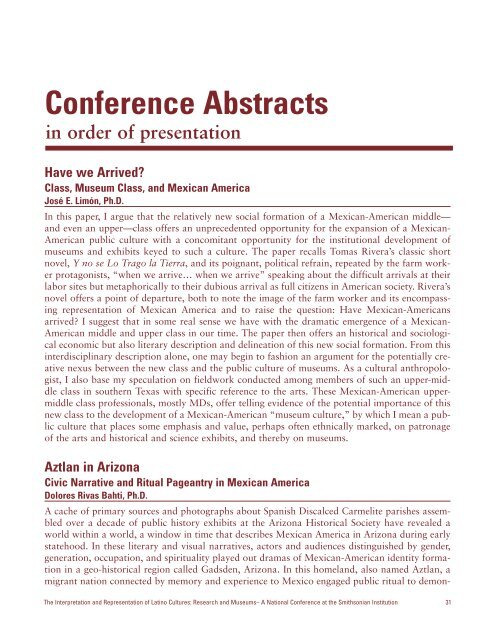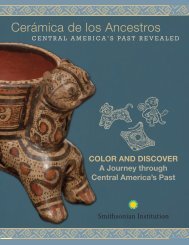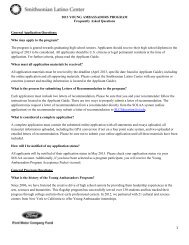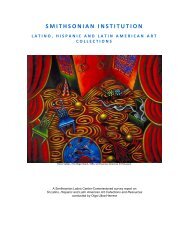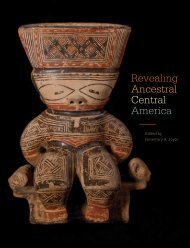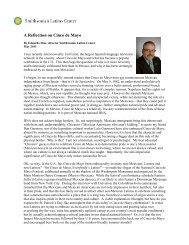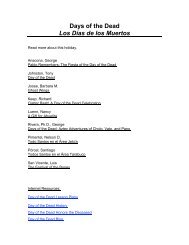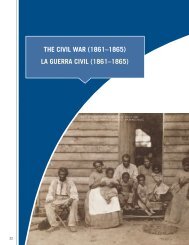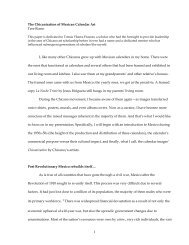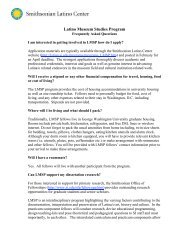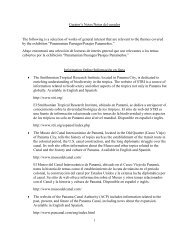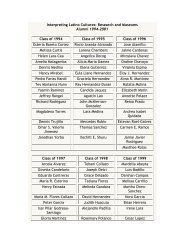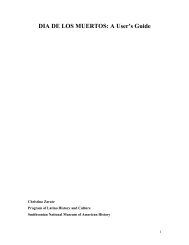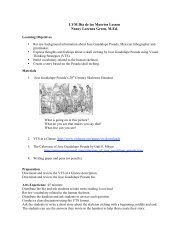Research and Museums - Smithsonian Latino Center - Smithsonian ...
Research and Museums - Smithsonian Latino Center - Smithsonian ...
Research and Museums - Smithsonian Latino Center - Smithsonian ...
Create successful ePaper yourself
Turn your PDF publications into a flip-book with our unique Google optimized e-Paper software.
Conference Abstractsin order of presentationHave we Arrived?Class, Museum Class, <strong>and</strong> Mexican AmericaJosé E. Limón, Ph.D.In this paper, I argue that the relatively new social formation of a Mexican-American middle—<strong>and</strong> even an upper—class offers an unprecedented opportunity for the expansion of a Mexican-American public culture with a concomitant opportunity for the institutional development ofmuseums <strong>and</strong> exhibits keyed to such a culture. The paper recalls Tomas Rivera’s classic shortnovel, Y no se Lo Trago la Tierra, <strong>and</strong> its poignant, political refrain, repeated by the farm workerprotagonists, “when we arrive… when we arrive” speaking about the difficult arrivals at theirlabor sites but metaphorically to their dubious arrival as full citizens in American society. Rivera’snovel offers a point of departure, both to note the image of the farm worker <strong>and</strong> its encompassingrepresentation of Mexican America <strong>and</strong> to raise the question: Have Mexican-Americansarrived? I suggest that in some real sense we have with the dramatic emergence of a Mexican-American middle <strong>and</strong> upper class in our time. The paper then offers an historical <strong>and</strong> sociologicaleconomic but also literary description <strong>and</strong> delineation of this new social formation. From thisinterdisciplinary description alone, one may begin to fashion an argument for the potentially creativenexus between the new class <strong>and</strong> the public culture of museums. As a cultural anthropologist,I also base my speculation on fieldwork conducted among members of such an upper-middleclass in southern Texas with specific reference to the arts. These Mexican-American uppermiddleclass professionals, mostly MDs, offer telling evidence of the potential importance of thisnew class to the development of a Mexican-American “museum culture,” by which I mean a publicculture that places some emphasis <strong>and</strong> value, perhaps often ethnically marked, on patronageof the arts <strong>and</strong> historical <strong>and</strong> science exhibits, <strong>and</strong> thereby on museums.Aztlan in ArizonaCivic Narrative <strong>and</strong> Ritual Pageantry in Mexican AmericaDolores Rivas Bahti, Ph.D.A cache of primary sources <strong>and</strong> photographs about Spanish Discalced Carmelite parishes assembledover a decade of public history exhibits at the Arizona Historical Society have revealed aworld within a world, a window in time that describes Mexican America in Arizona during earlystatehood. In these literary <strong>and</strong> visual narratives, actors <strong>and</strong> audiences distinguished by gender,generation, occupation, <strong>and</strong> spirituality played out dramas of Mexican-American identity formationin a geo-historical region called Gadsden, Arizona. In this homel<strong>and</strong>, also named Aztlan, amigrant nation connected by memory <strong>and</strong> experience to Mexico engaged public ritual to demon-The Interpretation <strong>and</strong> Representation of <strong>Latino</strong> Cultures: <strong>Research</strong> <strong>and</strong> <strong>Museums</strong>– A National Conference at the <strong>Smithsonian</strong> Institution 31


